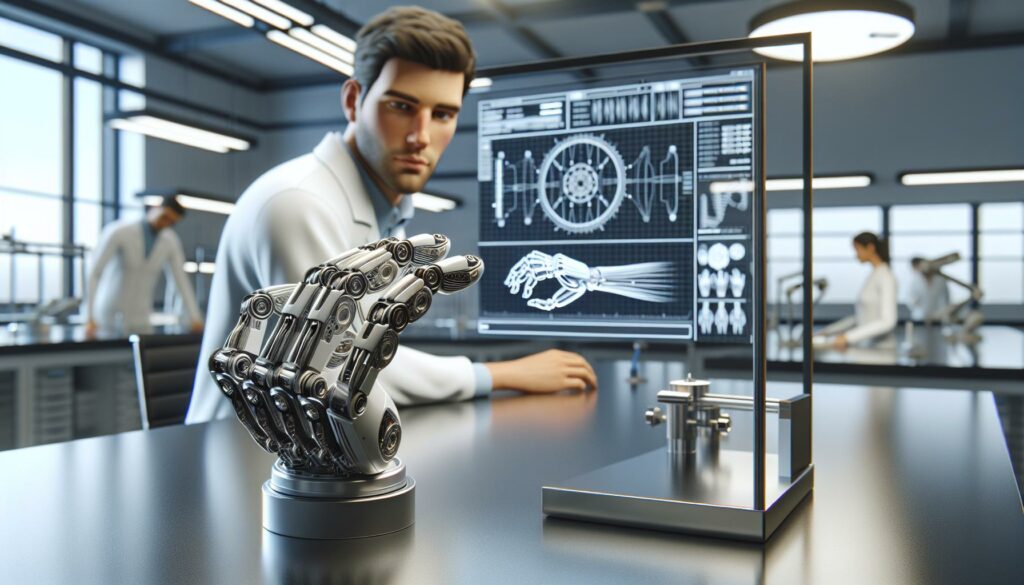When I first stumbled upon the world of left-hand robotics, I was captivated by its potential to revolutionize how we interact with machines. This niche branch of robotics focuses on designing and developing systems that mimic the dexterity and functionality of the human left hand. As we dive deeper into this fascinating field, it’s clear that left-hand robotics isn’t just about creating tools; it’s about enhancing human capabilities and bridging the gap between man and machine.
The implications of left-hand robotics stretch across various industries, from healthcare to manufacturing. By exploring innovative designs and applications, we can unlock new possibilities for efficiency and precision. Join me as I uncover the latest advancements and discuss how these robotic systems are shaping the future of technology.
Key Takeaways
- Definition and Purpose: Left hand robotics focuses on developing robotic systems that replicate the dexterity and functionality of the human left hand, enhancing human-machine interactions across various industries.
- Key Characteristics: These robotic systems exhibit high levels of dexterity, intelligence through advanced algorithms, and collaboration capabilities that integrate seamlessly with other systems.
- Technological Foundations: Essential technologies include sensors for real-time data collection and actuators for precision movement, along with sophisticated control systems that coordinate these elements for efficient task execution.
- Diverse Applications: Left hand robotics transforms industries like healthcare with surgical advancements and rehabilitation support, and manufacturing by improving assembly and quality control processes.
- Challenges Ahead: Ongoing technical challenges, such as sensor development and ethical considerations related to job displacement and data usage, must be addressed for successful implementation of left-hand robotics.
- Future Trends: Advancements include enhanced dexterity, AI integration, remote operations, and increased focus on ethics and accessibility, promising a collaborative future between humans and robots.
Left Hand Robotics
Left hand robotics focuses on developing robotic systems that emulate the dexterity and functionality of the human left hand. This technology plays a crucial role in enhancing human capabilities, allowing for improved interactions with machines. Its applications span across various industries, notably healthcare and manufacturing, where precision and adaptability are essential.
Key characteristics of left hand robotics include:
- Dexterity: Robotic systems are designed to execute intricate tasks that require fine motor skills, mimicking the movements of the human left hand.
- Intelligence: Advanced algorithms enable these robots to learn from their environments, enhancing their efficiency and functionality over time.
- Collaboration: Left hand robotics often integrates with other systems, fostering seamless human-robot collaboration in diverse settings.
The advancements in left hand robotics mark a significant step forward in automation and human-technology interaction. Their potential to transform industries and improve everyday tasks highlights the importance of ongoing research and innovation in this field.
Key Technologies in Left Hand Robotics
Left-hand robotics relies on several key technologies that enable precise manipulation and interaction. These technologies enhance the robot’s ability to mimic the complexities of human left-hand functions.
Sensors and Actuators
Sensors play a crucial role in left-hand robotics by gathering real-time data from the environment. I utilize various sensors, such as tactile, proximity, and vision sensors, to facilitate accurate feedback and interaction. Tactile sensors detect touch and pressure, enabling robots to grasp objects of different shapes and sizes. Proximity sensors help the robots identify obstacles and navigate their surroundings. Vision sensors, including cameras and depth sensors, allow for environmental assessment and object recognition. Actuators, on the other hand, convert electrical signals into physical motion. I use a range of actuators, such as servo motors and pneumatic systems, to achieve smooth and precise movements that replicate human-like dexterity.
Control Systems
Control systems are essential for coordinating the actions of sensors and actuators in left-hand robotics. I implement advanced control algorithms that process sensory input and provide real-time responses. These algorithms can include model-based control, which uses mathematical models to predict outcomes, and adaptive control, which adjusts based on changes in the environment. Moreover, I employ machine learning techniques to enhance the robot’s ability to learn from experiences and improve its performance over time. The integration of robust control systems ensures that the robot performs tasks efficiently and accurately, leading to seamless human-robot collaboration.
Applications of Left Hand Robotics
Left-hand robotics offers transformative applications across various sectors. This technology enhances efficiency and precision in tasks typical of human interactions.
Industrial Use
Left-hand robotics plays a pivotal role in industrial settings. Robots equipped with left-hand capabilities excel at handling tasks like assembly, packaging, and quality control. Increased dexterity allows for intricate manipulation of components, yielding higher production rates and improved safety. For instance, collaborative robots (cobots) are deployed alongside human workers to streamline assembly lines, reducing the risk of repetitive strain injuries. Moreover, left-hand robots can adapt to varying product shapes and sizes, maximizing efficiency and minimizing downtime.
Healthcare Applications
In healthcare, left-hand robotics revolutionizes patient care and surgical procedures. Surgical robots equipped with left-hand functionality allow for precise movements in minimally invasive surgeries, leading to faster recovery times and reduced complications. Robots assist in rehabilitation, enabling patients to regain mobility through personalized therapy exercises. Additionally, left-hand robotics facilitates medication management through automated pill dispensing systems, ensuring accurate dosages and enhancing patient safety. The integration of this technology improves overall healthcare outcomes and enhances the quality of life for patients.
Challenges and Limitations
Left-hand robotics faces various challenges and limitations that must be addressed to maximize its effectiveness and safety. Understanding these issues is crucial for advancing technology and ensuring successful integration into human environments.
Technical Challenges
Technical challenges significantly impact the development of left-hand robotics. Developing sensors that closely replicate human tactile feedback proves complex and costly. Addressing the limitations of current actuator technologies can hinder precise movements required for intricate tasks. Additionally, achieving seamless integration between hardware and software remains a hurdle, as advanced algorithms need continual refinement to enable real-time learning and adaptability.
The reliability of control systems plays a critical role. Ensuring that these systems manage sensor data and actuator movements efficiently poses technical obstacles. Another factor includes the variability in human left-hand usage across individuals, presenting difficulties in programming robots to accommodate diverse needs. Overcoming these challenges demands interdisciplinary collaboration among engineers, software developers, and researchers.
Ethical Considerations
Ethical considerations arise with the advancement of left-hand robotics. Issues related to job displacement emerge, as increased robot automation may threaten employment in certain sectors. Ensuring equitable access to robotic technologies is paramount, as disparities could lead to unequal benefits in various industries.
Responsible data usage is vital when employing sensors that gather user interaction data. Protecting personal information fosters trust between humans and robots. Additionally, establishing guidelines for robot interaction in sensitive environments, like healthcare, ensures that ethical standards maintain patient privacy and well-being. Addressing these ethical issues is crucial for society to fully embrace the benefits of left-hand robotics technology.
Future Trends in Left Hand Robotics
Emerging trends in left-hand robotics highlight significant advances and potential developments in this field.
- Enhanced Dexterity: Future robots focus on improved dexterity, enabling them to perform more intricate tasks with precision. Advanced control algorithms will facilitate finer movements that mirror human left-hand capabilities.
- Integration of Artificial Intelligence: Incorporating AI into left-hand robotics enhances decision-making and adaptation to diverse environments. Intelligent systems analyze data from sensors, allowing robots to learn and refine their tasks over time.
- Telepresence and Remote Operation: Trends indicate growth in telepresence applications, where operators control robots from remote locations. This capability will expand the utility of left-hand robots in sectors like healthcare, offering specialists the ability to perform procedures from a distance.
- Collaborative Robotics: The future signals increased collaboration between humans and robots. Left-hand robots equipped with sensors will seamlessly work alongside human counterparts, optimizing workflows in industries such as manufacturing and logistics.
- Miniaturization of Components: As technology progresses, sensors and actuators will become smaller and more efficient. This miniaturization allows left-hand robotics to integrate into more compact systems, enhancing portability and versatility.
- Adaptive Learning Systems: Future left-hand robots will utilize adaptive learning systems. These systems minimize the need for manual programming, allowing robots to adapt quickly to changing tasks and environments.
- Focus on Ethics and Accessibility: Ongoing discussions highlight the importance of ethical considerations and equitable access to technology. Future developments emphasize creating standards that promote responsible use of left-hand robotics, ensuring technology benefits all segments of society.
- Collaborative Research and Innovation: Collaborative research initiatives will drive innovation in left-hand robotics. Partnerships between academia, industry, and healthcare sectors will foster the development of cutting-edge technologies and practical applications.
The integration of these trends will shape the future landscape of left-hand robotics, enhancing precision, efficiency, and human-robot collaboration across various sectors.
Machines Interaction with Human
Left-hand robotics is paving the way for a future where machines can seamlessly interact with humans. The advancements in dexterity and intelligence not only enhance efficiency but also open doors to innovative applications across various sectors. As I reflect on the potential of this technology I’m excited about the transformative impact it can have on industries like healthcare and manufacturing.
Addressing the challenges associated with left-hand robotics is crucial for responsible development. I believe that with collaborative research and ethical considerations at the forefront we can harness this technology for the greater good. The journey of left-hand robotics is just beginning and I’m eager to see how it evolves in the coming years.

